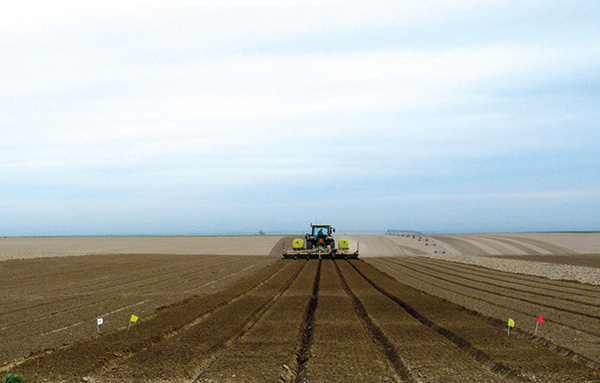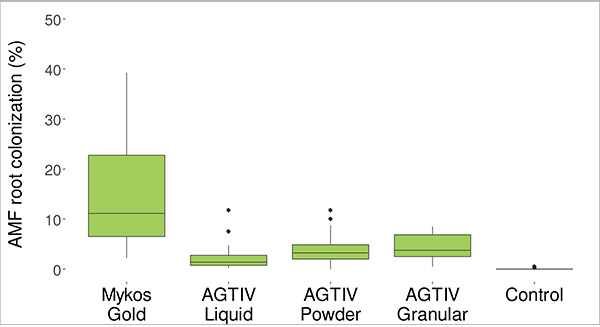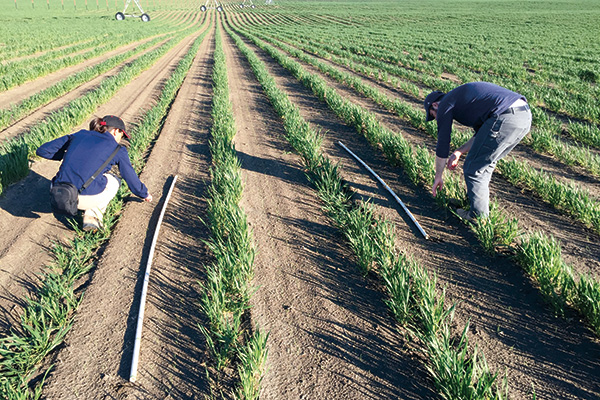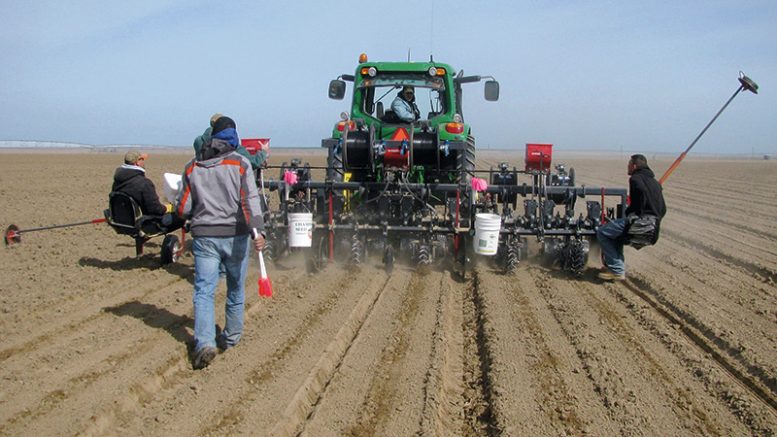The Effects of Mycorrhizal Inoculants on Onion Crops in the Columbia Basin
By Louisa Winkler, Lindsey du Toit and Tim Waters, Washington State University
In a survey taken at the Washington State University (WSU) 2018 Onion Cultivar Demonstration and Field Day, held in central Washington state, 43 percent of farmers reported having used arbuscular mycorrhizal fungal (AMF) inoculants in onion or other crops. Of crop consultants and agronomists taking the survey, 21 percent said they had recommended AMF inoculants to clients.
Are these AMF products effective? Several years ago, seeing the increasing number of commercial AMF inoculants in the marketplace, Lindsey du Toit, WSU plant pathologist, and Tim Waters, WSU regional vegetable specialist, set out to test these products in commercial onion crops grown in the semi-arid Columbia Basin of north-central Oregon and central Washington to determine their impact on onion crop performance.

What are AMF Inoculants?
AMF are a class of fungi, usually soil-borne, that form associations with the roots of most plant species, including onion. They facilitate soil nutrient and water acquisition by crop plants and can improve tolerance of plants to some abiotic stresses such as drought and salinity, as well as some biotic stresses such as certain soil-borne pathogens.
Intensely-worked agricultural soils typically have reduced concentrations of AMF because cultivation disrupts the fungal association with plant roots. Soil fumigation also can have adverse effects on these beneficial fungi. Adding AMF back into the soil before or during seeding of a new crop could increase crop yield and quality while also reducing fertilizer requirements.
Companies such as Reforestation Technologies International (RTI-Ag), AGTIV (formerly Premier Tech Agriculture), Plant Health LLC and Mycorrhizal Applications, Inc. have launched a variety of granular, powder, liquid and other formulations of products containing propagules of certain key AMF identified as having potential benefits for plants. These AMF inoculant products have been used successfully in many perennial cropping systems (e.g. in the forestry, nursery and landscape industries) and for producing transplants. However, AMF inoculants have been evaluated far less in direct-seeded, annual cropping systems. Since more than 95 percent of onion bulb crops in the Columbia Basin are direct-seeded, du Toit and Waters led a research and extension project to help evaluate the potential benefits for onion producers in the Columbia Basin.
| Product | Manufacturer |
| AGTIV Specialty Crops Granular | AGTIV, Quebec, Canada |
| AGTIV Specialty Crops Liquid | AGTIV, Quebec, Canada |
| AGTIV Specialty Crops Powder | AGTIV, Quebec, Canada |
| BioTerra Plus Dry Mix | Plant Health LLC, Corvallis, Ore. |
| MycoApply Endo Liquid | Mycorrhizal Applications LLC, Grants Pass, Ore. |
| MycoApply Ultrafine Endo Powder | Mycorrhizal Applications LLC, Grants Pass, Ore. |
| Myconate AS | Plant Health Care, Inc./SYM-AGRO, Inc. |
| Myconate HB | Plant Health Care, Inc./SYM-AGRO, Inc. |
| Mykos Gold Granular | RTI-Ag, Gilroy, Calif. |
| Mykos Liquid Mycorrhizal Inoculant | RTI-Ag, Gilroy, Calif. |
Table 1. Commercial arbuscular mycorrhizal fungi (AMF) products evaluated in field and growth chamber trials by Washington State University researchers.
Field Trials, Growth Chamber Trials
From 2015 to 2018, 20 field trials were completed to test 10 commercial AMF inoculants (Table 1) on six commercial onion farms in the Columbia Basin. Growers used their own equipment and their standard fertilization and pest control programs. In each trial, treatments were replicated and randomized to the extent possible with large-scale growers’ equipment. Products were applied according to manufacturers’ recommendations, most often by banding in the seed furrow at planting. Each trial always included control plots with no AMF inoculant.
In each field trial, onion stand counts were measured about six weeks after planting. In addition, onion plants were dug carefully mid-season to measure plant height and weight, assess foliar nutrient status and rate soil-borne disease severity (pink root and/or white rot). Samples of the roots were stained and examined microscopically to calculate the extent of root colonization by AMF. Bulb yield (size and weight) was also determined for each plot from mature onion bulbs.
In addition to the field trials, AMF inoculants were evaluated under controlled conditions in growth chamber trials. Soil for these trials was sampled from an onion grower’s field in the Columbia Basin. The soil was pasteurized to eliminate AMF present in the soil, so that any AMF activity detected was from the inoculants added. Onion growth and AMF root colonization were measured in these trials to compare results with the field trials.
In almost all the field trials, AMF inoculants did not cause an increase in onion root colonization rates. Of the various products tested, the most effective was Mykos Gold Granular. In the most successful field trial, this product increased root colonization rates from 48 percent in the control plots to 51 percent. When Mykos Gold Granular was applied to pasteurized soil in the growth chamber trials, root colonization levels ranged from 30 percent to 80 percent, whereas roots in control soil had 0 percent colonization. As in the field trials, Mykos Gold Granular was the most effective product tested in growth chamber tests.
Initially, many of the grower-cooperators expressed interest in treating onion seed with liquid formulations of AMF inoculants because of the ease of application (no need to modify their equipment if the product could be applied to seed). However, liquid formulations proved to be even less effective than granular formulations in growth chamber trials, even when the products were applied to seed that had not been treated with fungicides or seed that had not been pelleted for precision planting. Five trials with liquid AMF formulations in commercial fields were similarly disappointing.

AMF in Non-Inoculated Fields
In the field trials, onion roots generally showed 40 to 50 percent colonization in non-inoculated control plots to which no AMF inoculant had been added. This indicated that root-colonizing AMF were present in the soil of these commercial production fields, even fields that had been fumigated the fall prior to planting with metam sodium applied through center pivots.
This was similar to results of two AMF surveys in onion bulb crops in 2014-2015 completed by du Toit’s group with Tim Paulitz, USDA-ARS plant pathologist. For the first survey, AMF communities and root colonization rates were compared in five organic onion crops and four conventional onion crops. For the second survey, AMF were compared in eight conventional onion fields, four of which had been fumigated the autumn prior to planting with metam sodium (center-pivot chemigation) and four of which were not fumigated. AMF colonization of onion roots sampled mid-summer was greater in organic fields than conventional fields (67 versus 51 percent), and less in fumigated versus non-fumigated conventional fields (45 versus 67 percent).
Molecular analyses showed that four main AMF dominated in these soils (Glomus, Claroideoglomus, Paraglomus and Diversispora). The AMF communities were slightly more diverse and abundant in the organic crops than the conventional crops. However, there was no consistent effect of metam sodium on the species composition of AMF communities in onion crops in fumigated versus non-fumigated conventional fields.

Figure 1. Onion root colonization by arbuscular mycorrhizal fungi (AMF) in a growth chamber test of the product Mykos Gold Granular and three formulations (liquid, powder and granular) of AGTIV. The trial was repeated. The data were averaged over both trials. In other growth chamber trials, AMF root colonization reached as much as 80 percent with Mykos Gold Granular.
In Search of Explanations
Why were AMF inoculants ineffective at increasing onion root colonization in most of the field trials? Perhaps the fungi in these inoculants were not able to compete with AMF already present in the soils. Another explanation is that AMF products delivered in the seed furrow were inhibited by fungicides in the seed coatings typically used in conventional onion crops in the Columbia Basin. FarMore FI500, for example, contains azoxystrobin and fludioxonil, fungicides that can have inhibitory effects on many true fungi such as AMF. Another possibility is that some of the commercial formulations evaluated failed to preserve the vigor of fungal propagules or limited the capacity for root colonization, as demonstrated with several liquid formulations in the growth chamber trials.
However, what was clear from this research was that less AMF root colonization occurred when soil nutrients were more concentrated, especially soil phosphorus (P). In some of the field trials, root colonization rates were compared for onions seeded with or without a pre-plant, banded fertilizer application. The results were striking: on average, AMF root colonization rates were 15 percent less in plots that received the pre-plant, banded fertilizer application than in plots that did not (Fig. 2). In companion growth chamber tests, the best inoculant, Mykos Gold Granular, was 76 percent less effective at causing AMF colonization of onion roots when soil P concentration was 74 versus 25 ppm, and 64 percent less effective at 45 versus 25 ppm. A large majority of the onion fields surveyed during these studies had soil P levels considerably greater than 40 ppm. The results suggest that AMF inoculants might be more effective in situations where available soil nutrients are in low concentration, or other stressful situations, such as where soil water is scarce. Other research has demonstrated the benefits of AMF inoculants to be most apparent when plants are under stress.

Figure 2. Rate of onion root colonization by arbuscular mycorrhizal fungi (AMF) in two growers’ field trials in which half the plots received an application of pre-plant, banded fertilizer (“+”) and half the plots did not (“-”). Onions growing in plots amended with Mykos Gold Granular were compared with onions growing in control plots that were not inoculated with AMF. AMF colonization rates were greater in plots without the pre-plant fertilizer application, regardless of whether or not AMF inoculant was added. There was little difference between AMF root colonization rates in the AMF-inoculated plots compared with the control plots.
Onion Crop Performance
Across all the field trials, AMF inoculants showed no consistent effects on onion growth characteristics measured. Even in the growth chamber trials, the benefits of AMF inoculants on onion growth were not observed when plants were grown in soil with moderate or high P levels. It appears that onion plants grown with adequate levels of fertilizer can access all the nutrients needed for optimum growth, even in the absence of AMF.
AMF inoculants may be of value under nutrient-limiting conditions or in crops exposed to other stresses. Several studies demonstrated a benefit to using AMF inoculants in onion transplant production as the AMF-colonized plants displayed greater tolerance to transplant stress than non-colonized plants. However, in the context of direct-seeded onion production practices in the Columbia Basin, AMF inoculants appear to offer little to no advantage to these crops.
Requests for publications resulting from this project can be sent to du Toit at dutoit@wsu.edu.



